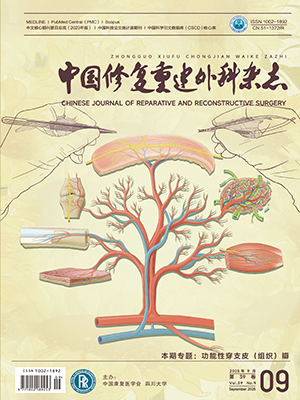| 1. |
Harris WH.Wear and periprosthetic osteolysis:the problem.Clin Orthop Relat Res,2001,(393):66-70.
|
| 2. |
Keener JD,Callaghan JJ,Goetz DD,et al.Twenty-five-year results after Charnley total hip arthroplasty in patients less than fifity years old:a concise follow-up of a previous report.J Bone Joint Surg (Am),2003,85-A(6):1066-1072.
|
| 3. |
邵振兴,蒋青.假体周围骨质溶解细胞分子生物学研究.国际骨科学杂志,2007,28(3):170-173.
|
| 4. |
Roato I,Caldo D,D'Amico L,et al.Osteoclastogenesis in peripheral blood mononuclear cell cultures of periprosthetic osteolysis patients and the phenotype of T cells localized in periprosthetic tissues.Biomaterials,2010,31(29):7519-7525.
|
| 5. |
Day JS,Baxter RM,Ramsey ML,et al.Characterization of wear debris in total elbow arthroplasty.J Shoulder Elbow Surg,2013,22(7):924-931.
|
| 6. |
Moon HJ,Yun YP,Han CW,et al.Effect of heparin and alendronate coating on titanium surfaces on inhibition of osteoclast and enhancement of osteoblast function.Biochem Biophys Res Commun,2011,413(2):194-200.
|
| 7. |
Qian Y,Zhang XL,Zeng BF,et al.Substance P enhanced titanium particles-induced RANKL expression in fibroblasts from periprosthetic membrane.Connect Tissue Res,2013,54(6):361-366.
|
| 8. |
奚正德,胡峻熊.RANKL-RANK信号传导与破骨细胞生成及骨病.中国骨质疏松杂志,2008,14(4):285-293.
|
| 9. |
Lähdeoja T,Pajarinen J,Kouri VP,et al.Toll-like receptors and aseptic loosening of hip endoprosthesis-a potential to respond against danger signals? Orthop Res,2010,28(2):184-190.
|
| 10. |
吕丹,孙明林.人工髋关节置换后假体无菌性松动的因素及其防治.中国组织工程研究与临床康复,2009,13(13):2553-2556.
|
| 11. |
李守民,朱晨,孔荣,等.人工髋关节置换术后翻修原因分析及预防.中国骨与关节损伤杂志,2010,25(12):1060-1062.
|
| 12. |
Pajarinen J,Kouri VP,Jämsen E,et al.The response of macrophages to titanium particles is determined by macrophage polarization.Acta Biomater,2013,9(11):9229-9240.
|
| 13. |
Han KH,Ryu JW,Lim KE,et al.Vascular expression of the chemokine CX3CL1 promotes osteoclast recruitment and exacerbates bone resorption in an irradiated murine model.Bone,2014,61(1):91-101.
|
| 14. |
Oue E,Lee JW,Sakamoto K,et al.CXCL2 synthesized by oral squamous cell carcinoma is involved in cancer-associated bone destruction.Biochem Biophys Res Commun,2012,424(3):456-461.
|
| 15. |
Asagiri M,Takayanagi H.The molecular understanding of osteoclast differentiation.Bone,2007,40(2):251-264.
|
| 16. |
Ryu J,Kim HJ,Chang EJ,et al.Sphingosine 1-phosphate as a regulator of osteoclast differentiation and osteoclast-osteoblast coupling.EMBO J,2006,25(24):5840-5851.
|
| 17. |
Ha J,Lee Y,Kim HH.CXCL2 mediates lipopolysaccharide-induced osteoclastogenesis in RANKLprimed precursors.Cytokine,2011,55(1):48-55.
|
| 18. |
田虹,樊瑜波.OPG、RANK、RANKL的结构、作用机制和在骨疾病中的作用.现代生物学进展,2010,10(20):3963-3966.
|
| 19. |
Theoleyre S,Wittrant Y,Tat SK,et al.The molecular triad OPG/RANK/RANKL:involvement in the orchestration of pathophysiological bone remodeling.Cytokine Growth Factor Rev,2004,15(6):457-475.
|
| 20. |
张波,郭艾.磨损颗粒引发假体周围骨溶解的机制及药物治疗进展.中国骨质疏松杂志,2007,13(8):596-599.
|
| 21. |
Kong YY,Yoshida H,Sarosi I,et al.OPGL is a key regulator of osteoclastogenesis,lymphocyte development and lymphnode organogenesis.Nature,1999,397(6717):315-323.
|
| 22. |
Veigl D,Niederlová J,Krystůfková O.Periprosthethic osteolysis and its association with RANKL expression.Physiol Res,2007,56(4):455-462.
|
| 23. |
王海,宋科官.磨损颗粒诱导假体周围骨溶解的机制及基因治疗现状.哈尔滨医科大学学报,2011,45(1):95-98.
|
| 24. |
Kong L,Yang C,Yu L,et al.Pyrroloquinoline quinine inhibits RANKL-mediated expression of NFATc1 in part via suppression of c-Fos in mouse bone marrow cells and inhibits wear particle-induced osteolysis in mice.PLoS One,2013,8(4):e61013.
|
| 25. |
Chun L,Yoon J,Song Y,et al.The characterization of macrophages and osteoclasts in tissues harvested from revised total hip prostheses.J Biomed Mater Res,1999,48(6):899-903.
|
| 26. |
耿磊,陈继营,陈城,等.假体周围组织冰冻切片对诊断髋关节假体无菌性松动的特异性分析.中国矫形外科杂志,2012,20(10):909-911.
|
| 27. |
Alias E,Dharmapatni AS,Holding AC,et al.Polyethylene particles stimulate expression of ITAM-related molecules in peri-implant tissues and when stimulating osteoclastogenesis in vitro.Acta Biomater,2012,8(8):3104-3112.
|
| 28. |
Granci D,Pellacani A,Spina M,et al.Serum levels of osteoprotegerin and receptor activator of nuclear factor-kappaB ligand as markers of periprosthetic osteolysis.J Bone Joint Surg (Am),2006,88(7):1501-1509.
|




